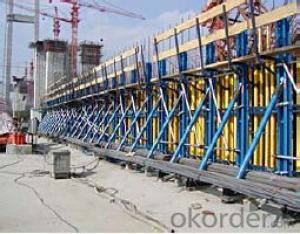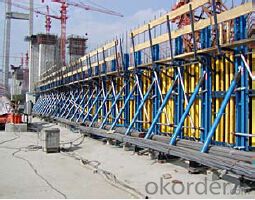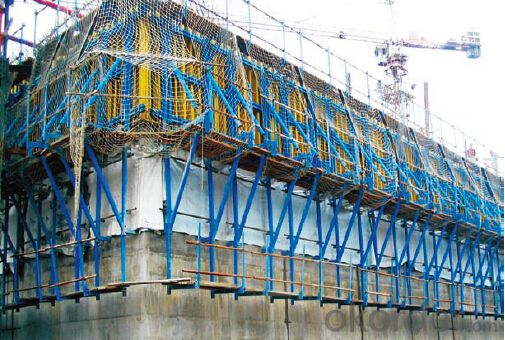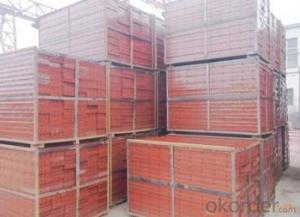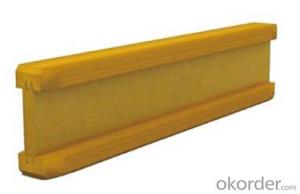Single-side climbing bracket for formwork and scaffolding system
- Loading Port:
- Tianjin
- Payment Terms:
- TT OR LC
- Min Order Qty:
- 50 m²
- Supply Capability:
- 1000 m²/month
OKorder Service Pledge
OKorder Financial Service
You Might Also Like
Single-side Climbing Bracket SCB180:
With CNBM SCB 180 climbing systems, the loads from the fresh concrete pressure are
transferred through the brackets by means of V-strongbacks and compression braces into the
scaffold anchors.
Typical applications for the SCB 180 are dams, locks, cooling towers, pier heads, tunnels, and
bank vaults.
The formwork is simply tilted backwards when striking takes place. The 1.80 m wide bracket
requires only a minimum of space.
Characteristics:
◆ Economical and safe anchoring
The M30/D20 climbing cones have been designed especially for single-sided concreting using
SCB180 in dam construction, and to allow the transfer of high tensile and shear forces into the still
fresh, unreinforced concrete. Without wall-through tie-rods, finished concrete is perfect.
◆ Stable and cost-effective for high loads
generous bracket spacings allow large-area formwork units with optimal utilization of the bearing
capacity. This leads to extremely economical solutions.
◆ Simple and flexible planning
With SCB180 single-sided climbing formwork, circular structures can also be concreted without
undergoing any large planning process. Even use on inclined walls is feasible without any special
measures because additional concrete loads or lifting forces can be safely transferred into the
structure.
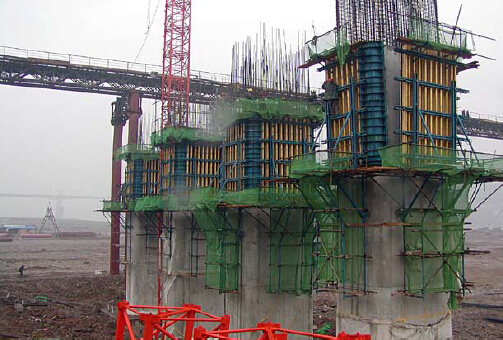
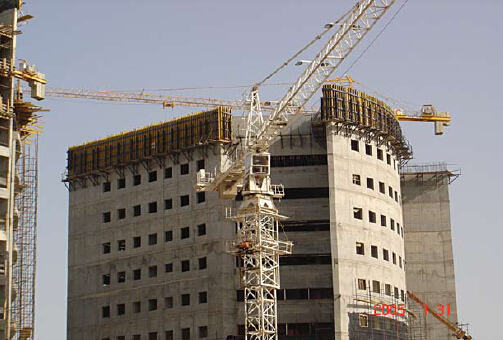
- Q: Is steel formwork suitable for projects with high formwork complexity?
- Steel formwork is a great option for projects that have intricate formwork needs. It can be customized and shaped to meet the requirements of complex projects, making it ideal for structures that are curved or non-standard. Furthermore, steel formwork is strong and durable, able to withstand the pressures and loads of construction. This makes it suitable for projects that require heavy reinforcement or large concrete pours. Additionally, steel formwork provides smooth and uniform surfaces, resulting in high-quality finishes. While it may require a higher initial investment, its long lifespan and reusability make it a cost-effective choice. Overall, steel formwork is a flexible, strong, and durable option that can provide high-quality finishes for complex projects.
- Q: Can steel formwork be used for both single-sided and double-sided forming?
- Steel formwork is capable of being utilized for both single-sided and double-sided forming. Renowned for its strength and durability, steel formwork is well-suited for various construction applications. In the case of single-sided forming, the steel panels are firmly secured against a solid surface or pre-existing structure, acting as a barrier to retain the concrete until it solidifies. Conversely, for double-sided forming, steel formwork panels are employed on both sides of the concrete pour, creating a mold that holds the concrete in place and provides a sleek finish on both sides of the structure. The versatility of steel formwork permits its utilization in a wide array of construction projects, encompassing walls, columns, beams, slabs, and more.
- Q: Can steel formwork be used for marine construction projects?
- Yes, steel formwork can be used for marine construction projects. Steel is a durable material that can withstand harsh marine conditions, including exposure to saltwater, waves, and corrosive elements. Steel formwork provides the required strength and stability to withstand the forces exerted by the marine environment. It can be used for various marine construction applications, such as building seawalls, piers, jetties, and offshore structures. Additionally, steel formwork offers advantages such as easy assembly and disassembly, reusability, and the ability to create complex shapes and structures. However, proper corrosion protection measures, such as galvanization or the use of anti-corrosive coatings, should be implemented to ensure the longevity and performance of the steel formwork in marine environments.
- Q: What type of steel is used in steel formwork?
- The type of steel used in steel formwork is typically a high-strength, low-alloy (HSLA) steel. This type of steel is known for its excellent strength, durability, and resistance to corrosion. HSLA steel is commonly used in construction applications where a strong and long-lasting material is required to withstand the rigors of formwork. Additionally, the steel used in formwork is often treated with special coatings or finishes to further enhance its resistance to rust and other forms of degradation.
- Q: Is steel formwork more durable than other types of formwork?
- Compared to other types of formwork, steel formwork is undoubtedly more durable. This is due to the fact that steel is a robust and sturdy material capable of withstanding heavy loads and high pressures. Its resistance to wear and tear makes it ideal for construction projects that involve repetitive use of formwork. Unlike wood or plastic, steel formwork does not easily warp, crack, or deteriorate over time. This exceptional durability allows for multiple concrete pours without the need for frequent replacements, resulting in long-term cost savings. Furthermore, steel formwork's fire-resistant properties further enhance its durability and safety features. In conclusion, steel formwork is a reliable choice for construction projects, offering superior durability when compared to other types of formwork.
- Q: What are the different types of supports used in steel formwork systems?
- There are several types of supports commonly used in steel formwork systems. These supports are essential in providing stability and ensuring the integrity of the formwork during the concrete pouring process. Some of the different types of supports used in steel formwork systems include: 1. Adjustable Steel Props: These are telescopic steel tubes with adjustable lengths that are used to support the formwork vertically. They provide stability and can be easily adjusted to the desired height. 2. Soldier Beams: Soldier beams are horizontal structural members that are used to support the formwork panels. They are typically placed at regular intervals and provide support to the vertical formwork panels. 3. Horizontal Walers: Horizontal walers are horizontal supports that are placed on top of the soldier beams. They help distribute the load evenly across the formwork system and provide additional support to the formwork panels. 4. Vertical Walers: Vertical walers are vertical supports that are used to connect the horizontal walers to the ground or any existing structure. They help transfer the load from the formwork system to the ground and provide stability to the overall structure. 5. Bracing Systems: Bracing systems are used to provide lateral support and prevent any lateral movement or deformation of the formwork system. They are typically made of steel rods or tubes and are placed diagonally between the vertical supports. 6. Ties and Tie Rods: Ties and tie rods are used to hold the formwork panels together and prevent them from bulging or moving during the concrete pouring process. They are typically made of steel and are placed at regular intervals along the formwork system. 7. Foundation Supports: Foundation supports are used to provide support to the vertical walers and transfer the load to the ground. They are typically made of steel or concrete and are placed below the vertical walers. These are some of the different types of supports used in steel formwork systems. The choice of supports will depend on the specific requirements of the construction project, such as the height and size of the formwork, the load-bearing capacity needed, and the desired level of stability and safety.
- Q: What are the different types of formwork supports used with steel formwork systems?
- There are several types of formwork supports that are commonly used with steel formwork systems. These supports are designed to provide stability and strength to the formwork, ensuring that it can withstand the weight of the concrete during pouring and curing. 1. Adjustable Steel Shoring: This type of support consists of adjustable steel props or jacks that can be extended or retracted to the desired height. These supports are typically used for vertical or horizontal applications and can be easily adjusted to accommodate different formwork heights. 2. Scaffolding: Scaffolding is a versatile formwork support system that is commonly used in construction projects. It consists of a network of metal tubes and boards that can be assembled and disassembled to create a stable platform for workers and materials. Scaffolding can be used to support formwork systems in both vertical and horizontal applications. 3. Strongbacks: Strongbacks are horizontal supports that are used to provide additional strength and stability to the formwork system. These supports are typically made of steel beams or channels and are placed parallel to the formwork panels. Strongbacks help to distribute the load evenly and prevent deflection or deformation of the formwork. 4. Bracing: Bracing is used to provide lateral stability to the formwork system. It consists of diagonal or cross-braces that are placed between the vertical supports. Bracing helps to prevent any movement or displacement of the formwork panels during pouring and curing. 5. Tie Rods: Tie rods are used to hold the formwork panels together and provide additional strength. These rods are typically made of steel and are inserted through holes in the formwork panels. They are then tightened with nuts and washers to securely hold the panels in place. 6. Props and Soldiers: Props and soldiers are vertical supports that are used to hold up the formwork panels. These supports are typically made of steel and can be adjusted to the desired height. Props are used in conjunction with other supports, such as strongbacks or tie rods, to provide additional stability to the formwork system. Overall, these different types of formwork supports are essential for ensuring the stability and strength of steel formwork systems during construction projects. They help to distribute the load evenly, prevent movement or displacement, and provide the necessary support for pouring and curing concrete.
- Q: Can steel formwork be used for both vertical and horizontal concrete elements?
- Yes, steel formwork can be used for both vertical and horizontal concrete elements. Steel formwork has high strength and durability, making it suitable for various construction applications. It can be easily assembled and disassembled, allowing for efficient and versatile use in creating both vertical walls and horizontal slabs in concrete construction.
- Q: What are the limitations of using steel formwork?
- There are several limitations of using steel formwork in construction projects. Firstly, steel formwork is relatively expensive compared to other types of formwork materials such as wood or aluminum. This can significantly increase construction costs, especially for large-scale projects. Secondly, steel formwork is heavy and requires heavy machinery and equipment for transportation and installation. This can be challenging in areas with limited access or on sites with uneven terrain. Additionally, steel formwork requires skilled labor for proper installation and dismantling. This can create delays and increase labor costs if the workforce is not experienced in working with steel formwork. Moreover, steel formwork is not as flexible as other types of formwork materials. It may not be suitable for complex or irregular shapes, which can limit design possibilities. Another limitation is the potential for corrosion. Steel formwork is vulnerable to rust and corrosion, especially in environments with high moisture or chemical exposure. Regular maintenance and corrosion protection measures are essential to ensure the longevity of steel formwork. Lastly, steel formwork is not as environmentally friendly as other alternatives. Steel production involves significant energy consumption and carbon emissions, which can contribute to environmental degradation. Overall, while steel formwork offers strength and durability, its limitations in terms of cost, weight, flexibility, corrosion susceptibility, and environmental impact should be carefully considered before choosing it for construction projects.
- Q: Production of steel plate for bridge steel plate SPHC and Q235 which material is good? What is the difference?
- Equivalent to GB GB699 (high quality carbon structural steel national standard) in the 10#, 15# steel hot-rolled plate, their carbon content range is about 0.1-0.15%.Q235 is the national standard GB700 (carbon structural steel national standard)
Send your message to us
Single-side climbing bracket for formwork and scaffolding system
- Loading Port:
- Tianjin
- Payment Terms:
- TT OR LC
- Min Order Qty:
- 50 m²
- Supply Capability:
- 1000 m²/month
OKorder Service Pledge
OKorder Financial Service
Similar products
Hot products
Hot Searches
